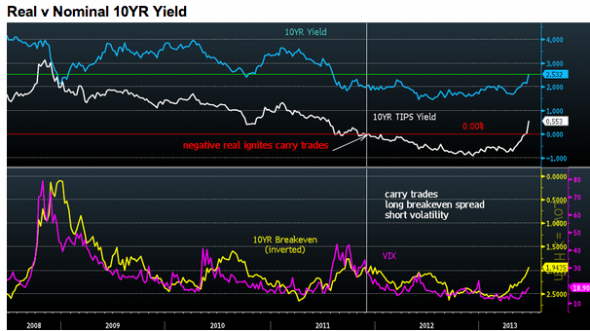From FT Alphaville:
Which came first, rising real rates or taper fear?
The Fed has rumbled the markets with QE exit/taper talk. That, at least, is the standard explanation with regards to the EM sell-off and other market turbulence.
But what if all this wasn’t started by the Fed, as much as the sudden rise in real rates in the last few months? A rise, we should add, that was prompted not by falling inflation expectations as much as underwhelming US CPI prints. (Itself, arguably prompted by Abenomics.) So as CPI underwhelmed, funding costs spiked.
All of which, by raising the real cost of money, began to disturb the fine balance propping up the biggest dollar-funded carry trade of all time – which depended on consistent CPI prints to ensure cost of money in real terms was negative.
As the cost of money rises, this is having a significant effect on funding hedges such as eurodollar futures. And rather than ease the money tightness, the Fed has just exacerbated the problem prompting collateral liquidations.
That at least is the interesting theory being proposed by Vince Foster over at Minyanville, who’s been looking at the current disruptions from the perspective of the eurodollar pits.
As he notes, when the carry trade is “on” it has the side effect of seeing FX reserves decline at the Federal Reserve, as investors borrow in dollars and sell those dollars to invest in foreign currencies.
As Foster notes:
The market’s very levered long carry trade was not only predicated on the Fed’s negative interest rate regime but also on the specified time period the Fed has committed to keeping interest rates negative.But he notes, QE3 changed all that by making the timing of the period of negative real rates much less certain.
...MUCH MORE
